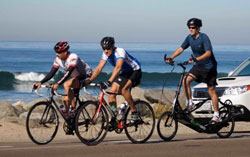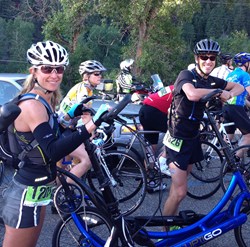 |
 |
 |
 |
 |
ElliptiGO UK Newsletter - Training Update: Aug 2014 |
 |
 |
 |
 |
 |
 |
 |
 |
|
 |
 |
 |
 |
 |
 |
 |
 |
 |
Join The ElliptiGO Global Team Challenge!!!
Points and pride are at stake in the inaugural Global Team Challenge(#GTC2014). We've divided all our ElliptiGO owners up into 5 equal teams, based on their global location.
From September 1 - 28th, you'll compete to help your Team get to the top of the leaderboard in each of four categories and
receive not only bragging rights for the year, but a lot of Get On The Map (GOTM) points as well!
Is your region the speedsters or the grinders? Can you be the team with the most participants? Get all the details and register by August 31st to be a part of the very first year of this competition!
UK riders remember, 4th September is National Cycle To Work Day, so why not put in an ElliptiGO cycle commute - and add to your points haul on that day!
|
| ElliptiGO Cycling Events: |
We've had lots of new ElliptiGO riders join us in the UK and many of you may be thinking of entering various cycling challenges to add an extra dimension to your training. If you are, why not consider some of these events which already have ElliptiGO riders entered.
If you are planning to enter any cycling events not on that list please update us so we can add your events to this list.
 |

|
|
|
 |
 |
 |
 |
 |
TRAINING:
How Does ElliptiGO Training Compare to Running or Cycling? |
|
We are often asked how riding the ElliptiGO compares to running and cycling, as an exercise and why an ElliptiGO workout feels so intense when compared to a conventional cycling workout.

There are many aspects to such a comparison and the main issues of interest are likely to be muscles used during the activity, post exercise recovery, posture, intensity, effect on the joints and calorie burn.
It's difficult to get accurate measured information on many of those variables but luckily many ElliptiGO riders also run (or have run) and also cycle (or have cycled) - so we get a lot of feedback from them about how the different exercises affect them and their perceptions of the above variables in the comparison.
The bulk of the customer feedback we get tends to
be quite uniform - and often mirrors the findings of one scientific study that was done specifically to compare running, cycling and riding the ElliptiGO. So I'll start off by looking more closely at that particular study.
The study was conducted by the Exercise and Physical Activity Resource Center (EPARC) at the University of California, San Diego (UCSD.) They determined that the energy cost of riding an ElliptiGO required, on average, 33% more effort than cycling on a road bike and that the heart rate responses and perceived effort levels were very similar between the ElliptiGO and running. We wont go into all the details of this study in this article, but you can read more about it on this link if you would like the finer details.

What that study didn't cover was muscle activation - determining which muscles are used the most in each activity. Thankfully, we do not need a lab of scientists to do this for us, any of us can get on a bike or an ElliptiGO - or just run - to find this out for ourselves.
The general consensus is that cycling works the cardiovascular system via the quads (predominantly) and, to a lesser extent, the calves (which are contracted statically when riding a road bike). Running works the cardiovascular system via all the muscles of the legs, with some use of the hip flexors and some glute activation. It also uses the postural muscles of the lower back statically.
Riding an ElliptiGO works the cardiovascular system using very
similar muscles to both running and cycling, but with more emphasis on longer contactions of the quads than running - and a much deeper glute engagement than either running or cycling. The torso postural muscles are also used statically on the ElliptiGO, like in running, but with much more torso emphasis than during running - and with much more core engagement than running - because the torso plays a stabilising and balancing role when riding an ElliptiGO.
These similarities to running are more easily portrayed in the video below:
The shoulders and arms also play a stabilising role when riding the ElliptiGO, which brings them into play more than in running or cycling, so it actually engages more of your muscle mass than either running or cycling - with most of the emphasis on the lower body - as with both the other forms of exercise.
This understanding of muscle engagement is quite key to defining the main differences between riding the ElliptiGO, running or cycling and understanding how best to use ElliptiGO training for fitness. Many people run, cycle or ride the ElliptiGO because they want to be fit and healthy - and to control their weight. Sport is often an extension of one's fitness goals and we take up sports like running and cycling because our core intention is to be fitter and healthier. That's why many people are interested to know what the core differences are between ElliptiGO training and
running and cycling, from which it originates.
The mainuses of the ElliptiGO, based on the above information, would be to condition the muscles used for running, without the impact and injury risks of running - which is great for bulking up or intensifying a running programme - and is also ideal for retaining one's fitness to run during periods of injury.
In addition, because the ElliptiGO challenges the muscles and cardiovascular system considerably more than riding a conventional rioad bike, one can burn considerably more calories per hour of riding, allowing an ElliptiGO rider to llose more weight and imporve cardiovascular fitness more from less training time. So whereas a one hour cycle does not tend to bring a great deal of fitness and weight loss on a road bike, a one hour ElliptiGO ride can be a lot like a one hour run.

Everyone who has experience in all three activities will swear by the statements made in the previous paragraphs - and the muscle engagement explanation gives us some insight into why this is so. ElliptiGO riders who are also conventional cyclists often remark on how much higher their hert rate is when they run or ride their ElliptiGO, compared to when they ride their road bikes. The explanation for this phenomenon derives from the earlier information discussed above.
When you cycle on a road bike you are using about 20% of your total muscle mass. So even if you push really hard, only a small amount of the total musculature is being used to exercise - hence the lower overall heart rate. On
an ElliptiGO you engage upwards of 70% of your total muscle mass. So when you ride the ElliptiGO your heart has to supply oxygen (and nutrients/calories) to most of your body's muscle mass - resulting in much more work for the heart. For this reason, even a moderate ElliptiGO ride will often generate a similar - or higher - heart rate (and calorie burn) compared to a very hard bike ride, on a road bike.
I hope this article has helped give better insight into this comparison and we'll continue to addres syour queries in further articles in future newsletters.

Idai Makaya
Lead Enthusiast
ElliptiGO UK
|
 |
|
 |
 Dealer and Retail Update: Dealer and Retail Update: |
We are pleased to welcome ElliptiGO Merseyside to the UK dealer network. ElliptiGO Merseyside operates from Meols, near Liverpool, and caters for customers in the Liverpool area. To book a test ride or day-hire please contact Peter Elliott via our contact@elliptigo.com email address.
ElliptiGO Preston are fully stocked with all colours of the ElliptiGO and now offer ElliptiGO day hire. Please contact Shane on 01772 744394 for more information, or to make a booking.
Please refer to our dealer locator for a view of all our dealer and representative locations, where test rides can be booked, or email us on contact@elliptigo.com.
 |
|
 |
|
 |
 |
 |
 |
| © 2014 ElliptiGO UK |
|
|